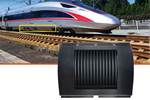Composite railway transom installation to replace timber alternatives
University of Southern Queensland researchers, in collaboration with Austrak, evaluate real-time conditions of FRP and water-based materials used on new Australian rainlway transoms.
Dr. Wahid Ferdous studying the composite transoms installed in Adelaide, Australia. Photo Credit: University of Southern Queensland
A collaboration between the University of Southern Queensland (Australia) and railway sleeper manufacturer Austrak (Australia) is on track after a team of engineering experts traveled to Adelaide to install sustainable composite railway transoms. The research team, led by the university’s chief investigator Dr. Wahid Ferdous, aims to replace timber transoms, a type of railway sleeper used in bridges, with a new material made from fiber-reinforced composite and waste-based materials.
The Queensland State government and Austrak have funded the project through an Advance Queensland Industry Research Fellowship, which Dr. Ferdous received in 2021.
“Fiber composites contribute to the product’s strength, while the waste-based materials contribute to its sustainability,” Dr. Ferdous explains. “We have found that combining these materials can produce a composite transom with a design life of around 50 years. This is more than three times longer than existing timber transoms, which last around 15 years, which means we can help significantly reduce track maintenance costs.”
Dr. Ferdous notes that the knowledge and experience shared between the university and its project partner Austrak has played an important role in validating these new transoms.
In July, Dr. Ferdous and his team traveled to South Australia to monitor nine composite transoms installed in a part of the state’s rail track under real-life loading conditions, which they then compared to the existing timber transoms.
“We found that the deflection of the rail track with the composite transoms was within the allowable track deflection limit,” Dr. Ferdous say. “I have conducted many tests on these composite transoms at the university’s laboratory, where I had the chance to critically evaluate their performance. But it’s exciting to see the research in action when it’s translated into a commercial product.”
Prof Allan Manalo, Institute for Advanced Engineering and Space Sciences acting executive director, says that the university has been working extensively on many research projects, with the team helping to translate research into reality. Learn more about the University of Southern Queensland’s Centre for Future Materials.
“This in-service performance evaluation will help demonstrate to railway engineers and authorities the durability and high-performance characteristics of polymer composite transoms and encourage the adoption of this new technology as an alternative to expensive and hard-to-secure hardwood timber for bridge transoms,” Manalo adds.
Dr. Ferdous says the team’s future goal is to optimize the performance and cost of these composite transoms to make them a more competitive product. He anticipates the new product will one day lead the Australian composite transom market while also attracting international interest.
Related Content
-
Plant tour: Joby Aviation, Marina, Calif., U.S.
As the advanced air mobility market begins to take shape, market leader Joby Aviation works to industrialize composites manufacturing for its first-generation, composites-intensive, all-electric air taxi.
-
Automotive chassis components lighten up with composites
Composite and hybrid components reduce mass, increase functionality on electric and conventional passenger vehicles.
-
McLaren celebrates 10 years of the McLaren P1 hybrid hypercar
Lightweight carbon fiber construction, Formula 1-inspired aerodynamics and high-performance hybrid powertrain technologies hallmark this hybrid vehicle, serve as a springboard for new race cars.















.jpg;maxWidth=300;quality=90)
